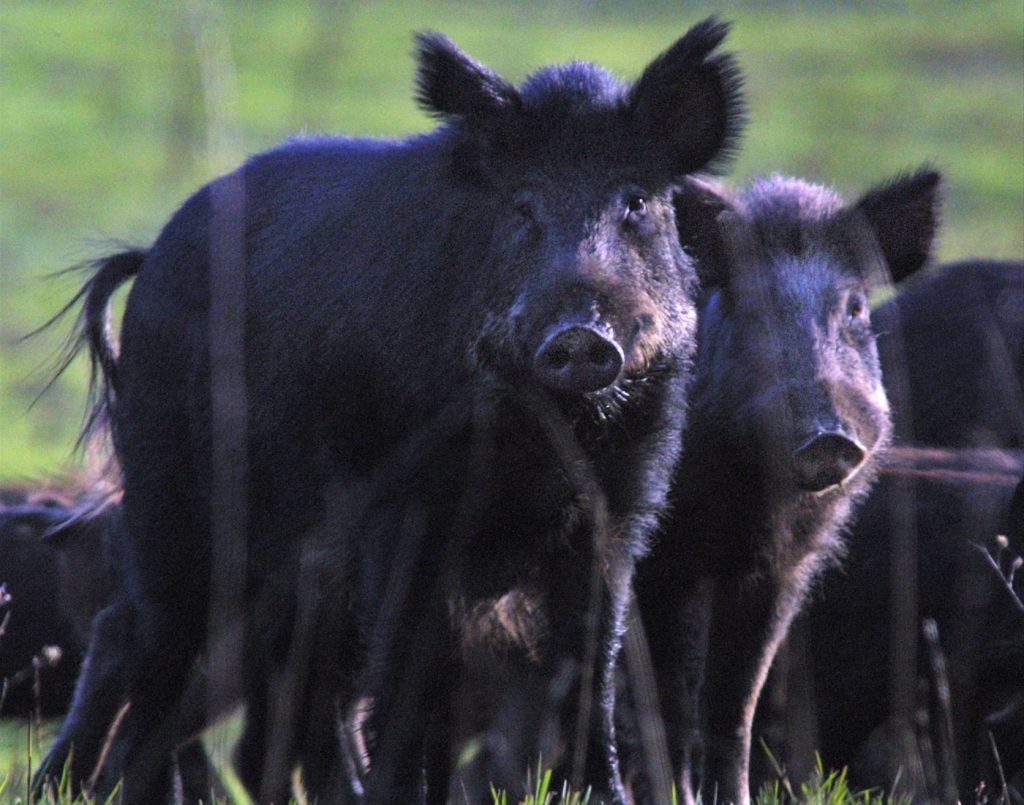Pigs running down the streets of Salinas?
“It’s not too far-fetched,” says Monterey County wildlife trapper Dan Burton of Urban Trapping Wildlife Control.
With incessant rain softening the ground and promoting plant and insect growth, Monterey County is experiencing a big pig problem. The wild boar/feral domestic pig hybrid mostly roams the foothills of the Santa Lucia range, both on the east side near the Salinas Valley and the west near Carmel and Carmel Valley. Local herds have been known to come into populated areas of Monterey County to dig up front lawns in search of grubs or uproot irrigation systems for a drink. The fertile herd grows like a weed and is equally as hard to get rid of. Wild game hunters and local wildlife trappers have their work cut out for them as Monterey County’s pig problem grows.
Modern-day Monterey County residents owe their impending pig problem to a lavish businessman named George Gordon Moore. In the early 1900s, Moore imported a dozen Eurasian boars from Russia and released them on his land, a parcel that is now part of the Santa Lucia Conservancy in Carmel Valley. The pigs he chose were spirited, with thick fur, short tails, and a razorback mane.
In a 1963 letter, Moore wrote: “The biggest boar we ever killed on the ranch, when hung, measured 9 feet from tip to tip. The skin on his neck was 3 inches thick; 11 bullets were found which over the years had been imbedded in the fat.
“The last time I saw William Randolph Hearst, Sr., he said, ‘Your pigs have reached San Simeon.’”
The pigs paid no mind to the borders of Moore’s property, and their knack for survival drove them to breed with local domestic pigs brought by the Spanish — hardy animals that grow like goldfish, that is, until you stop feeding them. Big-bodied domestic pigs have hallmark “Babe” features like curly tails and big, floppy ears. Nowadays, the roaming wild pig population of California is a characteristic and disgruntled mix of the two. The temperamental mutts are easily recognizable by their big ears, long curly tails, coarse fur and intimidating size.
After a series of run-ins with agricultural workers and moving vehicles, the pig trapping permits flowed more easily. (Photo by Dan Burton)
Poet Robinson Jeffers immortalized the history of the pigs in his poem, “Steelhead, Wild Pig, The Fungus”
And the grizzlies
Extinct, a wealthy amateur up the Carmel Valley brought in wild pigs
From the Urals to stock his hunting-park: they overswarmed it and broke his
borders and roam the coast-range, beautiful
Monsters, full of fecundity, bristled like a hedge at midnight; and the boars
with long naked
Knives in their jaws. They lair all day in impenetrable manzanita-thickets of
the farther mountain
And whet their knives at night on the farmer’s apple-trees.”
California ranks in the top 10 states “most impacted by feral hogs.” According to a 2018 report by the California Fish and Wildlife Department, wild pigs currently exist in 56 of the state’s 58 counties. Monterey County has the highest concentration of wild pigs in the state. Some estimates put the herd at somewhere between 200,000 and 400,000, but it’s hard to say, according to officials, because of the pigs’ ability to reproduce rapidly.
The pigs’ invasive activity and rampant impacts on the ground remain largely understudied.
“Nobody has collared them out here, so we don’t actually know how they move across the landscape,” said Emma Levy, an ecologist at Santa Lucia Conservancy. What we do know is that the herd is growing in size and boldness, coming down from the foothills and more often encountering park rangers and homeowners.
In August 2020, the River Fire thinned out the local herd, displacing and likely killing many of the pigs. When the fire finally died, the pigs’ primary water sources were fouled and dried up, so they wandered down from the foothills, following the smell of active irrigation.
Operations manager Byran Flores began working with the Monterey County Park Department that same year, during which he estimates the pigs caused $60,000 to $80,000 in damage to Toro Park.
“They root up irrigation lines, sprinklers, and turf looking for food,” said Flores.
Following the fire, they ripped up grass in search of grubs and beetles, uprooting irrigation lines, sprinklers, and turf in Toro and San Lorenzo Parks. At Lake San Antonio, one unlucky pig pushed open the door to a park bathroom and got trapped inside overnight, destroying the plumbing.
“My staff was going around doing checks when they saw water running out beneath the bathroom door. They opened the door, saw the pig, and shut it pretty quick. The rangers came down and shot the pig through the window,” said Flores.
Due to fire damages, Toro Park was closed to visitors through April 2021, so Flores and his team decided it would be safe to leave the irrigation system on to help out the pigs.
“They aren’t native, but they are part of our natural environment,” said Flores.
The only way to legally trap pigs in California is with a Department of Fish and Wildlife depredation permit, which is only distributed if an animal is causing damage to crops, landscapes, structures, livestock, poultry, or pets. (Photo by Dan Burton)
Upon reopening the parks, pig damage ran deep, so Flores contracted Dan Burton from Urban Trapping Wildlife Control to start trapping the pigs. Since then, pig damage has sharply declined in the improved park picnic areas, which were previously targeted by the burly scavengers.
Burton and his team trap pigs on neighboring properties and around the region, covering most of the Monterey-Salinas Highway between River Road and San Benancio “with a live-feed motion sensor camera and good old-fashioned leg work,” said Burton. Their camera range depends on the season, but they work around Gonzales, Soledad, Greenfield, King City, and San Lucas.
In 2022, the passage of SB 856 relaxed restrictions on feral pig hunting, but even still, the only way to legally trap pigs in California is with a Department of Fish and Wildlife depredation permit, which is only distributed if an animal is causing damage to crops, landscapes, structures, livestock, poultry, or pets. After a series of run-ins with agricultural workers and moving vehicles, the pig permits flow more easily.
Burton and his team get permits, set traps, and put the pigs down the “quickest, most humane way possible: using a large caliber rifle,” said Burton.
California ranks in the top 10 states “most impacted by feral hogs.” (Photo by Dan Burton)
Most of the pigs average between 75 and 170 pounds, but some are much larger. “The biggest pig we caught broke our scale. He was breaking into sheds for horse and pig feed. If I had to guess, he was around 350 pounds,” said Burton.
Then, he and his team donate the pigs for meat. He has a long-running, informal distribution system with a unique group of local organic meat-eaters who are on-call and excited to pick up the pork. “It’s a silver lining in a bad situation that the animal has to get put down, but it doesn’t go to waste,” said Burton.
The pigs’ activity is more or less based on rainfall. They get more active in the spring when they have large litters, and the ground is wet, soft and easy to dig up. There is typically a pig boom again in the summer when their water sources dry up and drive them down the hills. According to Burton, some pig herds use the Salinas River as a highway. They hop in at San Lucas and sometimes run the river undetected all the way up to Salinas. When rains are heavy, and the river fills up, the pigs get pushed out and forage around the agricultural fields.
Related Articles
How much longer will Annie, Berkeley’s favorite peregrine falcon, continue to lay eggs?
Sea otters helping hold up California’s kelp forest
Possibility of wildlife-to-human crossover heightens concern about chronic wasting disease
Investigation into killings of 19 burros in California desert hits possible breakthrough
Triplets?! Big Bear eagles welcome 3rd egg of 2024
Levy believes a useful next step would be research on the pigs’ ecology to get a better understanding of their impact on the California landscape. “We have some understanding of what they eat, but we don’t know to the degree, or how they affect plant and tree recruitment or resources for other species,” said Levy.
According to research from Texas A&M, pigs are the most prolific large mammals on earth. They have, on average, around two litters a year. Piglets are susceptible to classic California predators like coyotes, mountain lions and Highway 1, but for the most part, they roam without fear.
“If they didn’t reproduce as fast as they did and cause as much damage, they could live in harmony with the other introduced animals like opossums and turkeys,” said Burton.
While Burton and his team work hard to keep the pig populations down, he says it’s important homeowners also take precautions to reduce run-ins. One way to manage pig damage on the front lawn is to call local pest control companies to control grubs in the soil so the pigs aren’t interested in rooting around in the first place. Installing pig fencing, securing livestock feed, and restricting bird feeders are also good strategies to keep the hogs at bay.
Burton predicts that a huge explosion of pig activity is inevitable after two years of heavy rain and increasing food sources. “They are definitely breeding,” said Burton. “When we have another drought, and their food sources start to die off and dry up, we are going to have a severe pig issue.”
Until then, mind your pets and your front lawns, and keep an eye out for herds of wild hogs.
“We put them out there, and now they are paying the price for it,” said Burton. “They are amazing animals and it’s really a bummer how good they are at surviving.”


